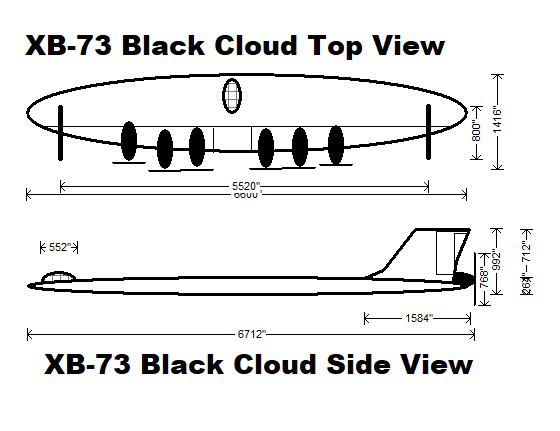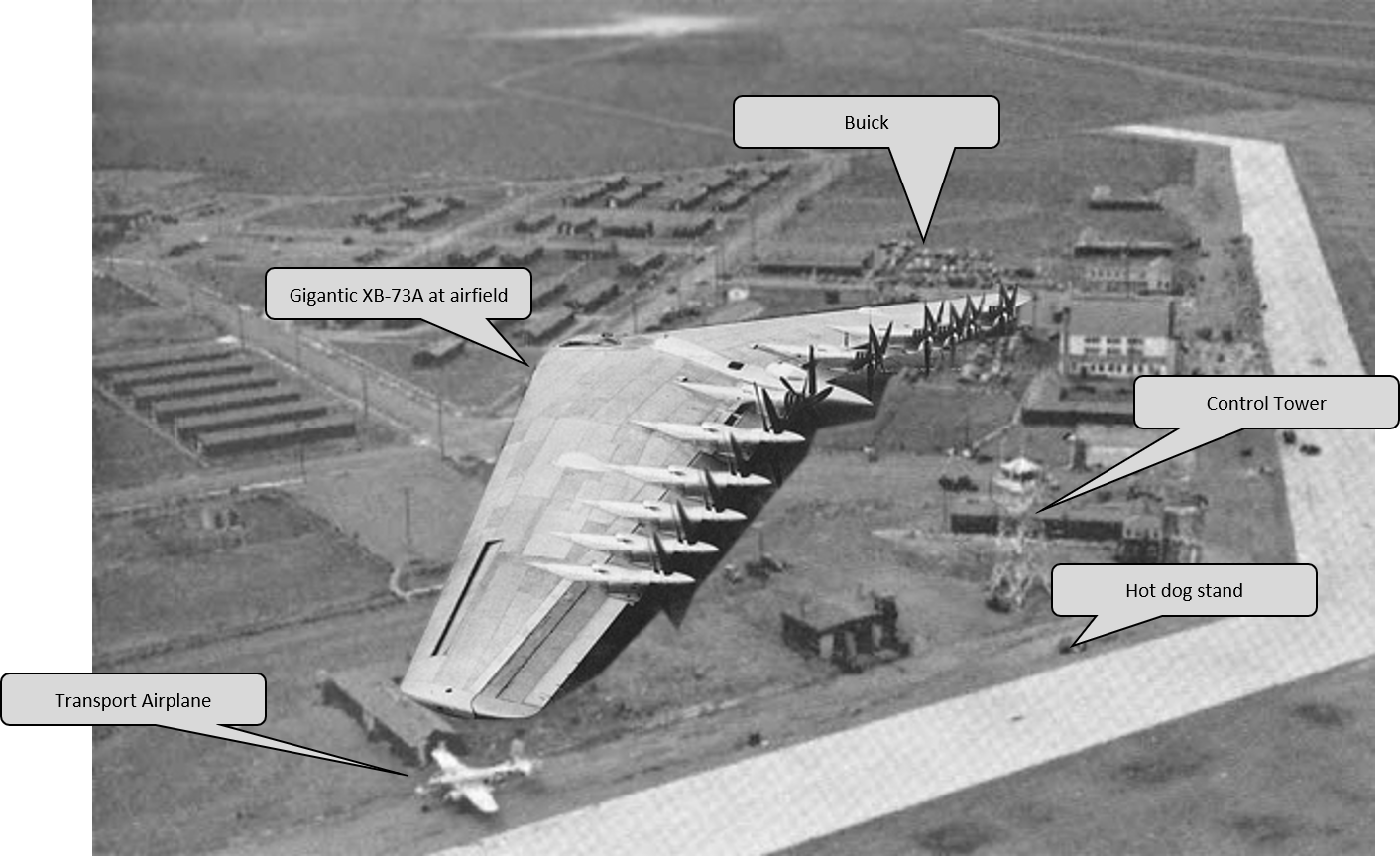THE XB‑73 BLACK CLOUD

For centuries, military strategists have desired the element of surprise. This was especially so for those studying the art of aerial warfare. Prior to the development of Stealth technology (the various methods of making aircraft invisible to radar detection), the US Air Force had researched ways to keep the enemy from locating and shooting down attacking airplanes. One of the most secret programs was the development and testing of the XB‑73 “Black Cloud” low level bomber.
Since the invention of the warplane, standard thinking had assumed that the best attack aircraft would be one that could fly at the fastest possible speed, swoop down on the enemy, attack swiftly, and then escape. During World War II the high-altitude bomber was developed. These planes, of which the B‑29 was one, flew relatively slowly (by today’s standards), certainly slower than the then-current fighters and interceptors, but did so at extremely high altitudes. Defensive systems were designed to stop slower high-flying bombers.
With the application of the jet engines, supersonic aircraft that could skim along at tree top level were built. Examples include the famous TFX (later, F-111). Thus, devices for detection of enemy aircraft were designed to detect ground hugging high speed machines. This resulted in two types of defense systems. The high altitude/slow speed and low altitude high speed detection and destruction dual-dynamic methodologies.
In the late 1950s and early 1960s the Top Secret Air Force XB‑73 “Black Cloud” program was initiated. This airplane was meant to baffle Soviet early warning systems by flying “against the profile.” Rather than fly high and slow or low and fast, the XB‑73 flew low and slow. The idea was that the “Black Cloud” would be used to deliver its deadly load of thermonuclear explosive devices at such a slow speed that the opposing radar systems would not recognize it as an incoming aircraft.
Two XB‑73s were built and tested. They were constructed at the super‑secret government facility in Nevada called the “Hog Wallow.” Located in an obscure corner of Bernstein Air Force Base, the Air Force will not even admit that the Hog Wallow actually exists or existed. In fact, the program is so secret that the Air Force refuses to acknowledge Bernstein AFB. Top aircraft designers and technicians hand-built the most sensitive of experimental airplanes. Nicknamed the “Diddlers”, the men and women at the Hog Wallow “diddled” the XB‑73 Black Cloud to life.
The XB‑73 had a wingspan of slightly more than 275 feet and was nearly oval in shape. Its skin was made of black titanium, hence the name “Black Cloud”. It was powered by six heavily muffled Wright 12‑cylinder 640 horsepower radial engines. Using counter‑rotating 4‑blade propellers, the huge engines could lift the XB‑73 to an altitude of over 200 feet and cause it to fly at speeds approaching 35 miles per hour. Because of the gigantic quad‑chamber muffling devices the machine was almost completely silent, except for a dull thudding sound that could be heard when the Black Cloud was directly overhead.
The two XB‑73s were built and tested at Bernstein AFB. A simulated attack was staged on Las Vegas. As predicted, air traffic controllers and radar systems did not recognize the Black Cloud when it was operating in Full Attack Mode (FAM). Approaching Las Vegas at its 5 miles per hour bombing speed it passed over the numerous houses and suburbs unobserved.
The XB‑73 program was abruptly canceled due to one tragic accident and an unforeseen problem. During the fifth flight test of the first Black Cloud, the airplane was destroyed when it crashed after hitting a hot air balloon. The balloon was in the process of inflating prior to lifting off on a sightseeing trip. After the low flying XB‑73 operating in FAM collided with the huge fabric bag it careened out of control at 2 miles per hour. The bomber’s crew escaped by lowering a rope ladder and climbing down. The navigator suffered minor injuries when he was forced to jump the last 4 feet and landed on a rock, twisting an ankle. The airplane itself smashed into the ground a short distance away and burned completely. The Air Force created a cover story to explain away this disaster. The gigantic flaming wreck, it was said, was a desert celebration by Beatnik poets called “Burning Cloud”. Clearly this became the historical antecedent to the Burning Man festival several decades later, which indicates a lingering governmental coverup.

But it was the other problem that ultimately caused the program to be discontinued. Because the bomber was designed to deliver nuclear weapons to Soviet targets, tests were conducted to determine the effectiveness of the aircraft during wartime. It was discovered during these tests that while the Black Cloud’s low speed was its greatest advantage, its speed was also the greatest problem. Operating in Full Attack Mode, the XB‑73 was supposed to take off from Strategic Air Command bases in the Midwest. It would then fly to the Soviet Union and drop its multi‑megaton cargo. However, calculations indicated that by flying in FAM, six months would elapse before the bomber would be over the target area. It is unlikely that this would have served any useful purpose because the target area would surely have been blasted by land-based ICBMs, submarine launched missiles, and other aircraft. It was considered improbable that a nuclear war would last six months. Conservative estimates placed the duration at closer to 45 minutes.
In addition, the slow FAM speed would not allow the plane and crew to escape the atomic blast after the nuclear device had been dropped. Experts concluded that it would take an extremely patriotic, or extremely stupid, crew to fly for six months only to be incinerated at Ground Zero.
Few records of the XB‑73 Black Cloud low level bomber program remain. Those that do are highly classified. No photos of the aircraft exist, but two rolls of blueprints are said to remain in a vault in Washington, DC.
A NOTE ON SOURCES:
Official documentation has been nearly impossible to obtain. Through the usual sources, the Freedom of Information Act and leaks, the details presented in the above article were gathered. Among the sources used were;
MY LIFE IN THE HOG WALLOW, Crichton, Louis. Unpublished memoirs.
BLACK PROJECT, BLACK CLOUD: The Story of the XB-73, Michael LeFarbre, USAF Documentation Office. 1963.
SPOOKS IN THE DESERT, or What’s Up There?, Booth, Edwin R., Papoose Publishing, Sparks, NV. 1988.
THE EVIDENCE PRESENTED, The Unexplained Aircraft Research Group, Aurora, CO. Undated.
FILE 351-A: Slow Aircraft Study, Air Foil Study Center, in-house document, unpublished. 1959.
